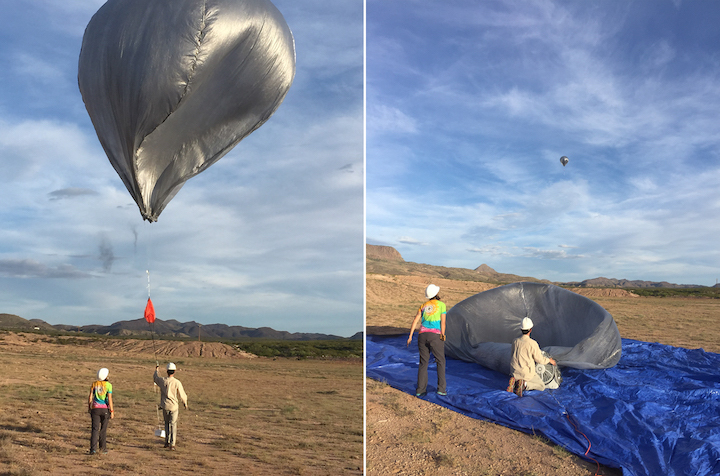But Sarah Albert, a geophysicist at Sandia National Laboratories in New Mexico, never gave up on the idea. She was intrigued by the potential of new solar-powered balloons that can float passively at stable altitudes and wireless telemetry that can broadcast data continuously over long ranges.
Equipped with modern technology, she and her colleagues drove to an airport near Albuquerque and on 14 April 2021 launched a balloon at sunrise. They timed the flight to coincide with the launch of Blue Origin’s New Shepard rocket, which was taking off more than 400 kilometers away in Van Horn, Texas. Floating within the presumed sound channel, the balloon picked up three clear signals from the rocket—one when it launched, and two more when it ascended and descended through the tropopause, the researchers revealed last week at the annual meeting of the Seismological Society of America. The observation marks the first verified infrasound detection of a distant airborne source with an airborne receiver, Albert says.

But to their surprise, the scientists also picked up other sounds in the channel. “There’s infrasound events of unknown nature that occur several times per hour,” says Daniel Bowman, a geophysicist at Sandia and collaborator on the project. “And there’s no good explanation.”
To make matters even more confusing, the team repeated the experiment with another rocket launch out of Vandenberg Air Force Base in California on 27 September 2021 and saw no signal at all. Although this new rocket launch was three times farther away than the one in Texas, they still expected the atmospheric SOFAR channel to carry the sound waves from the rocket to the balloon, Albert says.
“I do believe that there’s an atmo-SOFAR channel that exists,” Albert says. “But I’m not as confident it exists all of the time, and that it can channel sound as far as we had previously thought.” That makes sense, she adds, because winds and temperature variations make the tropopause a much more dynamic place than the stable ocean channel.
Going forward, the researchers plan to listen to launches with multiple balloons staggered at different altitudes to figure out where the channel’s effects are strongest. They also plan to test the range of the signals and investigate the mysterious background noise.
Understanding how the channel functions could help lay the groundwork for a future aerial infrasound network, which would monitor Earth constantly for major explosions and eruptions, Albert says. “In areas where there are volcanoes and limited infrasound networks, having a balloon or balloon network in the air could fill in that gap.”
When Hunga Tonga-Hunga Ha‘apai erupted in Tonga in January, for example, the closest ground-based detector was more than 750 kilometers away, McNutt says. Having a balloon array in place could help determine the location, time, and size of these remote incidents.
“The Earth is three-quarters water, and instruments don’t like being on the water,” Bowman says. “Having an airborne perspective … allows us to ask questions you simply can’t ask on the ground.”
Quelle: AAAS

